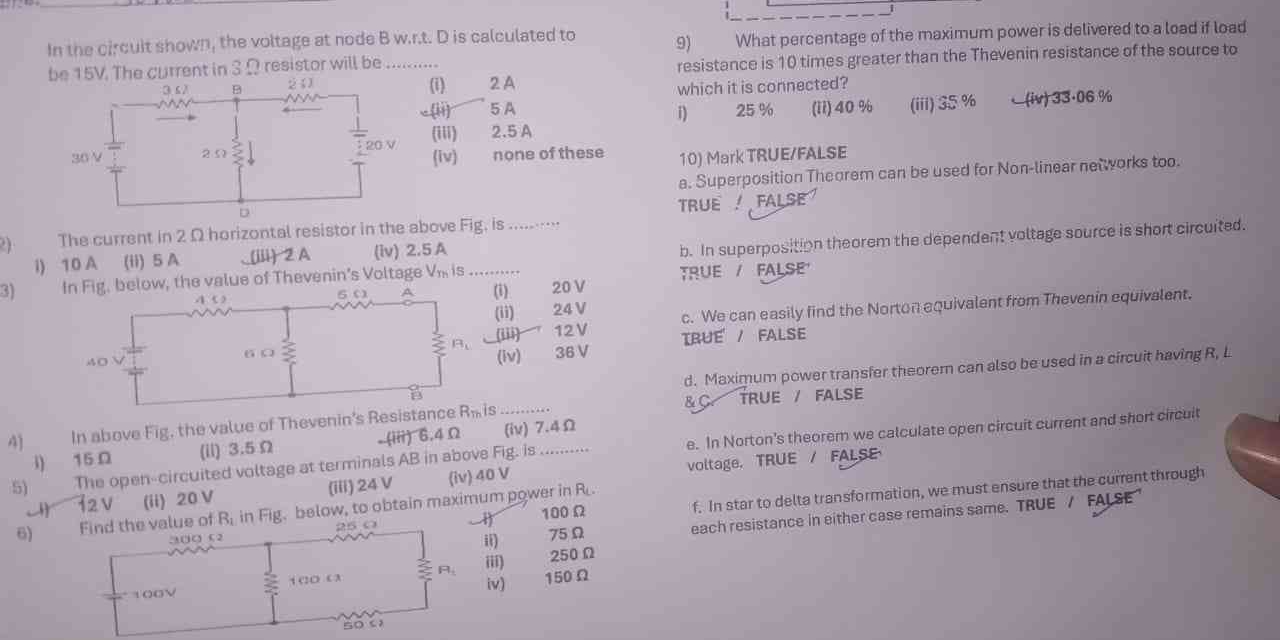In the circuit shown, the voltage at node B w.r.t. D is calculated to be 15V. The current in a 3Ω resistor will be ... The current in the 2Ω horizontal resistor is ... The value of... In the circuit shown, the voltage at node B w.r.t. D is calculated to be 15V. The current in a 3Ω resistor will be ... The current in the 2Ω horizontal resistor is ... The value of Thevenin's Voltage Vth is ... The value of Thevenin's Resistance Rth is ... The open-circuited voltage at terminals AB is ... Find the value of R1 ... Mark TRUE/FALSE for various statements about circuit theorems.

Understand the Problem
The question involves analyzing a circuit to determine values of current and voltage using Thevenin's Theorem and the Superposition Theorem. It consists of multiple sub-questions based on circuit theory concepts.
Answer
The current in the 3Ω resistor is $I = 2A$.
Answer for screen readers
The current in the 3Ω resistor is $2A$.
Steps to Solve
-
Calculate the Voltage at Node B (V_B) To find the voltage at Node B with respect to Node D, we need to analyze the circuit and apply voltage divider rules. The resistors connected to the 30V source will affect the total voltage drop.
-
Use Ohm's Law to Find Current in the 3Ω Resistor Once we have the voltage at Node B (V_B), we can use Ohm's Law to find the current ($I$) through the 3Ω resistor. The current can be calculated by the formula:
$$ I = \frac{V_B}{R} $$
where ( R = 3Ω ).
-
Identify the Correct Answer for the Current Compare the calculated current value against the given options (2A, 5A, 2.5A, none of these) and select the correct answer.
-
Determine the Current in the 2Ω Resistor The current through the 2Ω horizontal resistor can be found using the same method, determining the voltage across the 2Ω resistor and applying Ohm's Law.
-
Find Thevenin’s Voltage (V_th) For circuit analysis, we will find the open-circuit voltage across the terminals to find the Thevenin equivalent voltage ( V_{th} ).
-
Calculate Thevenin’s Resistance (R_th) We can find ( R_{th} ) by turning off all independent sources and calculating the equivalent resistance between terminals.
-
Calculate the Maximum Power Transfer To find the condition for maximum power transfer, we apply the formula related to ( R_{L} ) (load resistance) being equal to ( R_{th} ).
-
Percentage Power Transfer Calculation Use the formula for power transfer to find the percentage of power delivered to the load resistance compared to the total power available from the source.
The current in the 3Ω resistor is $2A$.
More Information
The calculations rely on basic circuit theory principles, including the usage of Ohm's Law and Thevenin's Theorem for equivalent circuit analysis. Knowing voltage dividers and current paths through resistors is crucial.
Tips
- Forgetting to account for all voltage sources can lead to wrong current calculations.
- Mixing up series and parallel resistor formulas when finding Thevenin equivalents.
- Neglecting to reset the circuit state (opening/closing sources) when determining equivalent resistance.
AI-generated content may contain errors. Please verify critical information